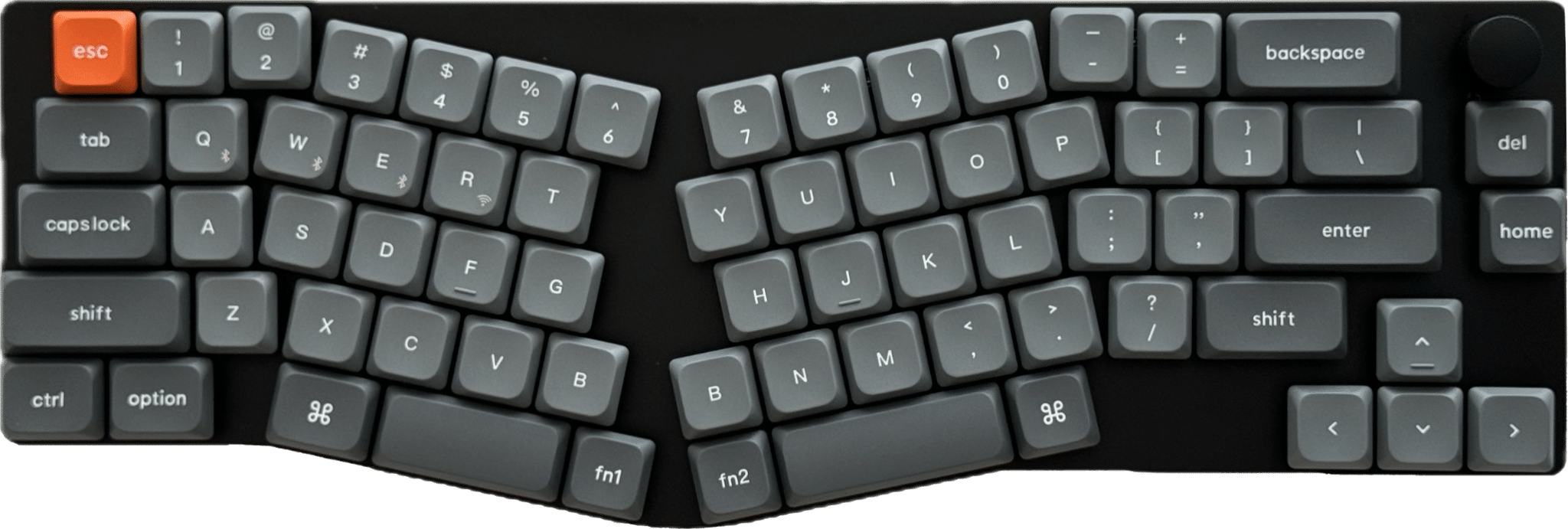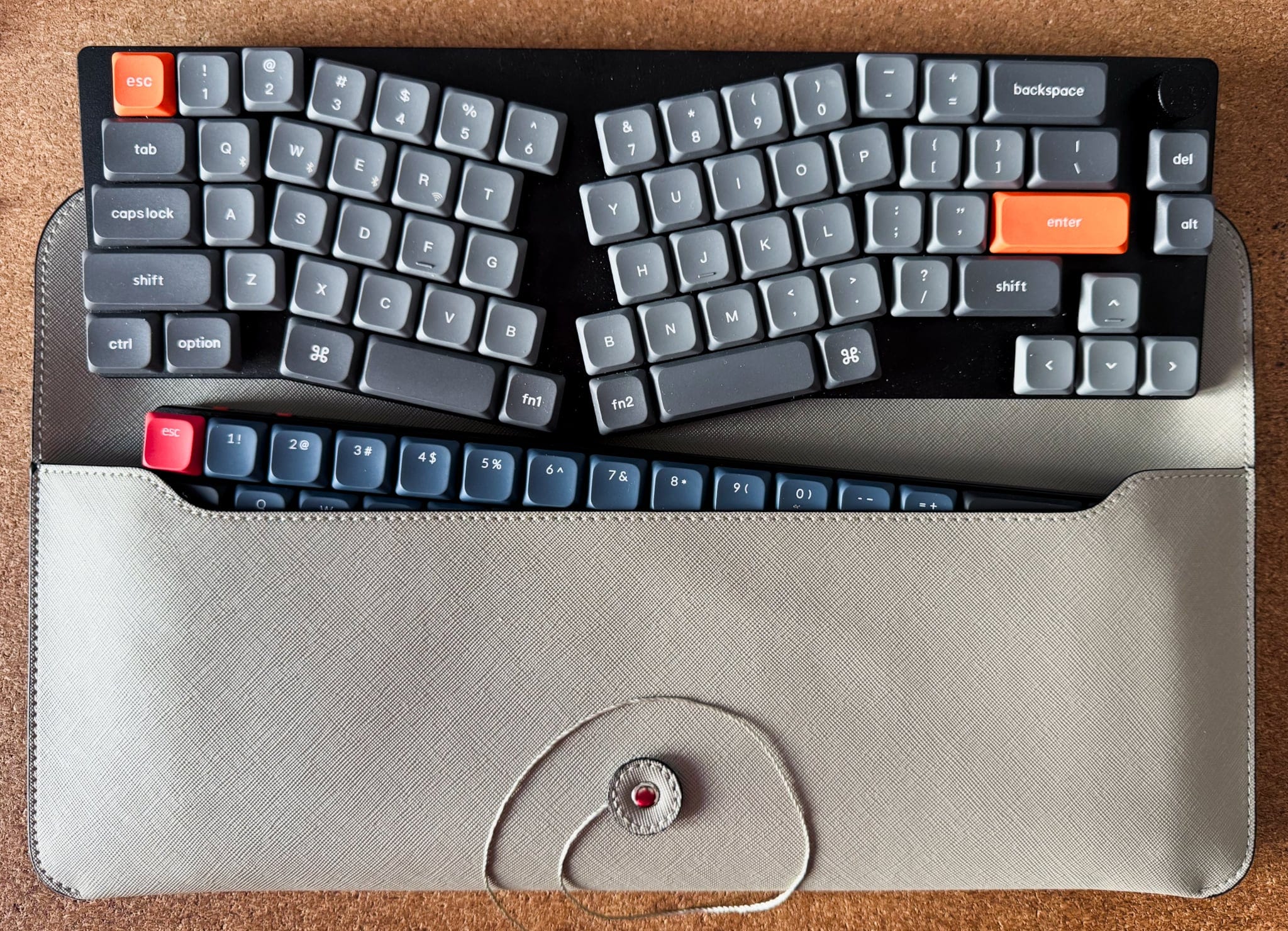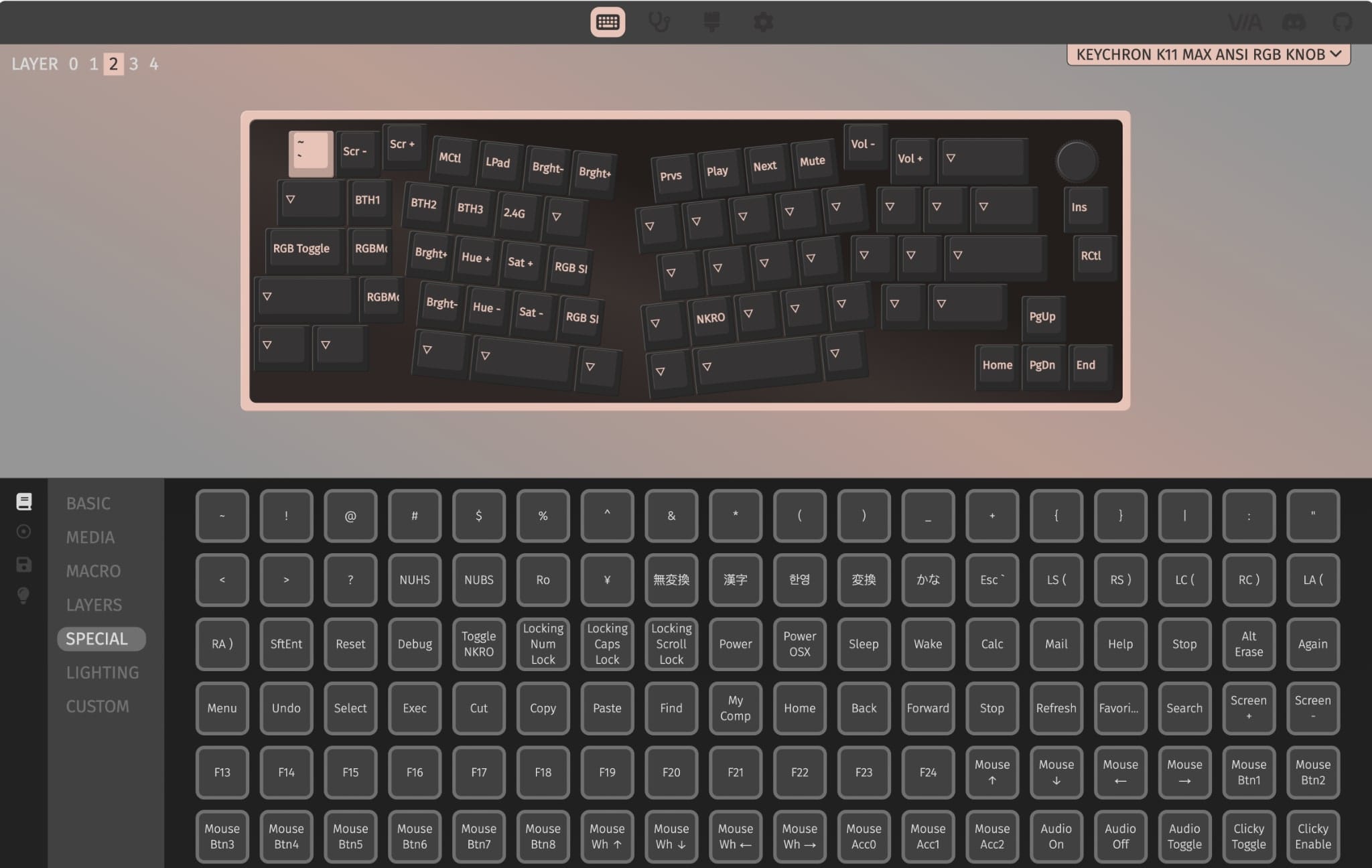A few weeks after I posted my review of the K7 Max, Keychron reached out to ask if I wanted to try out the K11 Max, a compact Alice layout keyboard–and I ended up saying yes.
Note: Keychron sent me an early review unit of the Keychron K11 Max and a travel pouch, and this piece follows my review policy–and was written after about a month of daily use.

Retrospective: My Past dealings with RSI
The main reason I said yes to trying the Keychron K11 Max is that I spent a good chunk of the mid-90s and early 2000s using a Microsoft Natural Keyboard, which, despite being bulky, was the only one that allowed me to work for long periods without experiencing RSI, specifically wrist and upper hand pain.
Part of the benefit for me at the time was indeed the layout and improved wrist position, and part of it was the key action, which was much better than the crappy Dell keyboards we had at the office.
The K11 Max doesn’t disappoint in either–the layout is very comfortable, and the red linear switches I got are identical to the K7 Max’s, with smooth travel and an early actuation point that makes typing a breeze.
In The Box
Like with the K7 Max, the box contains a braided USB-C cable, a 2.4GHz receiver (which, sadly, cannot be stored inside the keyboard), a quick start guide and an assortment of extra PBT keycaps to convert the keyboard to a Windows layout and swap the Esc and Enter keys with orange/grey variants.
The keyboard itself maintains the same high-quality fit and finish as the K7 Max, featuring similar mode switches, foldaway feet, and other familiar elements:

Detour: The Travel Pouch
Keychron also was kind enough to send me a travel pouch–which is how I now store and carry around the K7 Max these days:

The pouches come in several sizes, but the one I got fits both keyboards (with a little room to spare) and, despite being made of supple, flexible leather, is still rigid enough to protect your keyboard from bumps and sharp corners.
I found the string clasp to be a nice touch, since (unlike, say, spring-loaded studs, which are common in these things) it doesn’t force you to press on the keyboard to button it down.PO-POMN
Build and Form Factor
The build quality is, as you’d expect, great–the keyboard feels solid, stable and well-rounded, and really stands out on my desk.
Part of that is because, well, it is slightly bigger than I’m used to. I prefer small keyboards, and the K11 Max is a little wider than most.
But it’s still compact, and the extra width is mostly due to the extra hardware on the right side. Still, the “right” comparison would be with an Apple Magic Keyboard, which is definitely narrower:

I got sent an RGB model, which was… unusual for me. Since I’m not traveling with the K11 Max I didn’t feel the need for a backlight, so the PBT keycaps and their lack of transparency weren’t an issue (I left the backlight off all the time).
But, of course, what stands out (and dominates the look) is the layout.
Using The Alice Layout
Perhaps because of my history with the Microsoft Natural Keyboard, I had very little trouble adjusting to the K11 Max’s Alice layout.
The center break and key angles might be a little unsettling at first, but once you stop looking at the keyboard and get used to the slight shift involved in hitting QAZ and symbols it pretty much vanishes–although you should expect some off-by-one errors while you acclimatize.
The only real difference from a regular layout for a touch typist is that the fn keys are moved inside the split space bar (in the same place as the Ferris and other split keyboards)–and you get an extra B key.
In my experience, that actually made it easier to hit the essential fn key combinations:
fn1 + QthroughEswitch between up to 3 Bluetooth devices (which is one of its killer features for me)fn1 + Caps,S,XandAtweak the backlightfn2 + Bto display the battery status (more on that later)
There were, however, a few niggles that are quite specific to my personal habits:
- Like with the K7 Max, using
fn1 + Escfor the backtick (which is very common in Markdown and formatted JavaScript strings) andfn2 + Escfor tilde took a little getting used to. - I frequently hit the blank space to the left of the cursor keys with my thumb, as using the
Optionkey with the cursor keys is a common gesture for me. I resolved this issue by remapping keys using VIA, but I believe the K11 Max would benefit from having a dedicated rightAlt/Optionkey.
The Knob
And, of course… there’s a rotary encoder, which was a first for me. It’s got a nice tactile feel to it, both due to it being made of metal and the knurling on it:

As you’d expect, the default mapping for the rotary encoder is to change the volume and toggle mute by clicking it–which is pretty great, but a bit redundant at my main desk since I have a volume control puck (and a mixer) for my desktop speakers1.
But if, like me, you spend a lot of time writing, then remapping the rotary encoder to move your cursor (which of course I did) can be pretty useful to go back a couple of sentences and rephrase things quickly2.
Battery Life
A week after I started using the K11 Max, the battery died. That was unexpected since I had been able to run the K7 Max daily for at least twice as long without charging it, but I initially ascribed it to my having somehow left the backlight on or something similar.
However, after leaving it to charge for multiple hours, the battery never went past 80%, which was strange. Checking the battery by holding fn2 + B (a very nice trick that uses the LEDs in the number row as a battery gauge) was consistent with the Bluetooth reporting, so I just left it charging overnight.

After finally having gotten the battery to 100%, to my dismay it fell back to 80% within an hour and I again came back to find the keyboard at 40% the next morning, so clearly something wasn’t right…
I reached out to Keychron, and they sent me a replacement keyboard (they have a comprehensive warranty). The replacement has had no issues whatsoever (nor, by the way, has the K7 Max), so I’m ascribing this to the teething pains of reviewing early revisions of new hardware.
Using VIA
Just as the K7 Max, the K11 Max is fully QMK compatible, and provides five fully customizable layers that you can reconfigure using VIA and a compatible browser (I used Edge on my Mac).
Moving some of my K7 Max customizations over was trivial, but the one modification that made a significant difference in the K11 Max was remapping Home (one of the far right keys under the rotary encoder) to Option to have better cursor control (since with that I can use the movement keys for Home, End and word skipping).

As mentioned before, I also set the rotary encoder to move the cursor word-by-word when holding down fn1, and have been toying with the idea of using the right-hand ‘B’ key as a macro to invoke Shortcat–but since I am back to using Amethyst for managing my windows entirely via the keyboard, I am likely to just move that to a dedicated window management layer.
Conclusion
The K11 Max is a bit larger than the K7 Max and my usual preference for keyboards. However, it offers increased comfort and functionality, making it a worthwhile upgrade.
The only shortcomings I can see are:
- It is somewhat addictive, in a good way–I’ve become used to placing my wrists at its “better” angle, and I miss it when I have to use a laptop keyboard.
- It is missing, at the very least, a right
Optionkey (again, the empty space next to the cursor keys feels in need of filling). - I miss Touch ID. Like I mentioned in my K7 Max review, this is not Keychron’s fault, but given ny reliance on MFA authentication it is something I have felt the need for ever since I moved to mechanical keyboards.
The best endorsement I can give the K11 Max is that it has replaced the K7 Max on my desk.
As to the first review sample, I will be using it at my standing desk3 by running a cable to my Surface dock. It seems like a win-win situation, since it’s always been a little cramped and I don’t have any media controls there.
-
I will also often listen to music using PlexAmp on my ThinkSmart View. The audio for that is streamed to my speakers as well through a Pi that plugs into the mixer. It’s convoluted system, but it’s been working with zero friction. ↩︎
-
I am also going to try mapping it to transport controls in music apps, although that will require a little more experimentation since there aren’t really any standards for that. ↩︎
-
Although I will be looking at battery replacements–and might update this post in the future. ↩︎